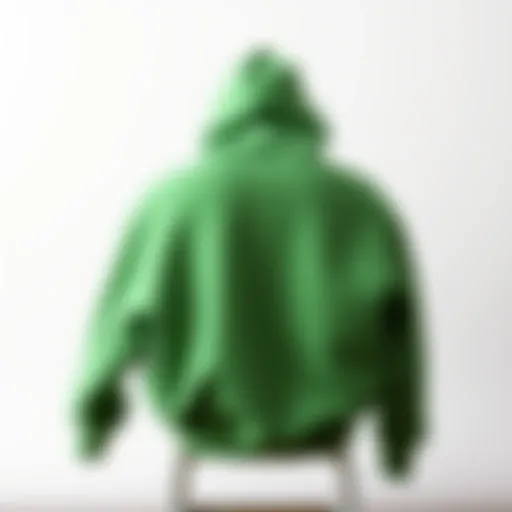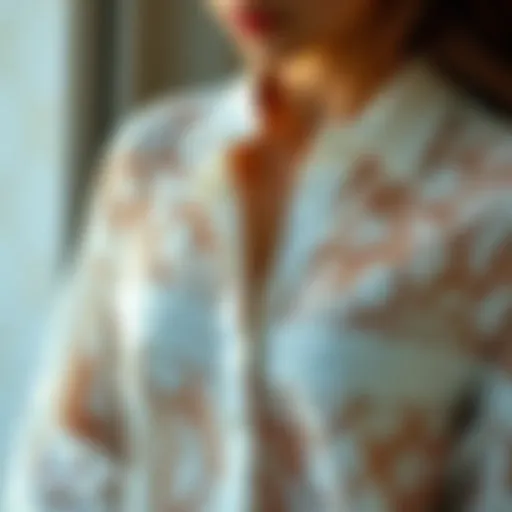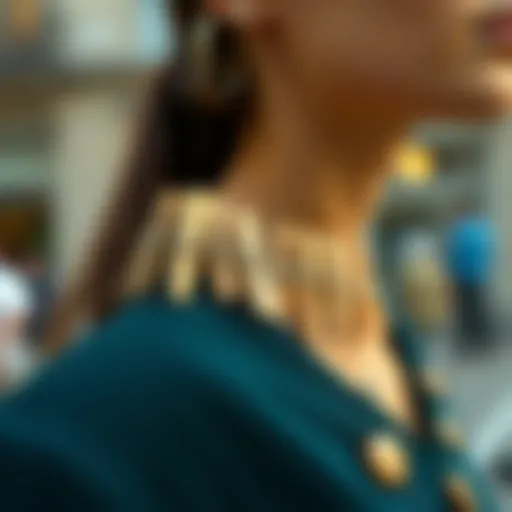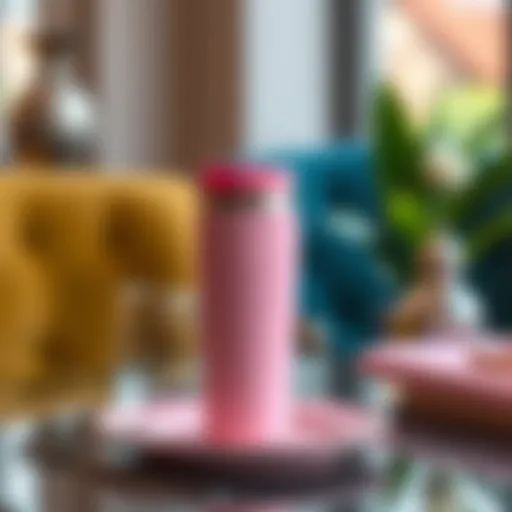Washi Tape in Scrapbooking: Creative Techniques Revealed
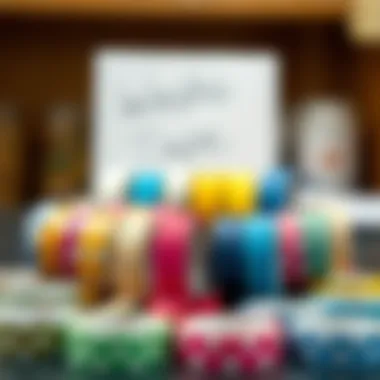

Intro
In recent years, scrapbooking has evolved from a simple hobby into an expressive art form, weaving stories and memories into tangible works of art. Among the many tools and materials available to scrapbook enthusiasts, washi tape stands out as a versatile and vibrant choice, appealing to both newcomers and seasoned scrapbookers alike.
Washi tape, with its colorful patterns and easy-to-use nature, provides endless possibilities for creativity. It originates from Japan, where it was traditionally used in various forms of art and decoration. The beauty of this tape is not just in its aesthetics but also in its ability to enhance the overall crafting experience. This article will explore the multifaceted role that washi tape plays in scrapbooking, examining its practical uses, aesthetic contributions, and creative applications.
As we dissect the world of washi tape in scrapbooking, a few key aspects will be highlighted:
- Its history and cultural significance
- Practical tips for using washi tape effectively
- Creative techniques that elevate scrapbooking projects
- How washi tape inspires organization and creativity
Throughout this narrative, we will assist readers in navigating the delightful world of washi tape, providing insights and advice that can transform ordinary scrapbook pages into extraordinary stories.
Overview of Scrapbooking
Scrapbooking has grown far beyond a simple pastime; it's a vibrant creative outlet that allows individuals to preserve memories while expressing their unique identities. This piece dissects the essence of scrapbooking, considering its historical roots and its significance in the contemporary craft world.
Historical Context
The origins of scrapbooking trace back to the 15th century, though similar practices can be seen even earlier. In those days, people compiled collections of recipes, poems, and press clippings, binding them in handmade books. The modern scrapbooking movement, however, truly came into its own in the 1980s, propelled by the DIY culture and a surge in interest for personalized artistry. During this era, companies began to produce specialized materials and tools, making scrapbooking more accessible to the masses.
It's crucial to understand that scrapbooking is not just about gluing pictures into a book; it's a rich narrative canvas where personal stories intertwine with artistic expression. This practice reflects the social and technological changes of its time. Digital photography and the internet have transformed how people approach scrapbooking, adding layers of ease and accessibility. Today, scrapbooking melds traditional techniques with modern technology, allowing enthusiasts to explore and innovate their craft.
Purpose and Significance
The importance of scrapbooking extends beyond mere decoration; it serves as a mindful practice that fosters creativity and emotional wellness. Engaging in scrapbooking can be therapeutic, providing an avenue for reflection and emotional processing. By crafting pages filled with cherished memories, scrapbookers not only celebrate life’s milestones but also create tangible heirlooms that tell their unique stories.
Moreover, scrapbooking cultivates a sense of community among crafters. Local workshops, social media groups, and online forums thrive with shared ideas, tips, and encouragement. The supportive atmosphere amplifies creativity while enabling individuals to learn from one another.
From personal journals to sharing family histories, scrapbooking undeniably holds significant value in today’s fast-paced world. As we delve deeper into the role of washi tape within this context, we unlock a myriad of creative possibilities that enhance the scrapbooking experience.
"Scrapbooking is an art of moments, binding memories into a visual narrative that lasts a lifetime."
In the coming sections, we will explore how washi tape enhances this practice, inspiring scrapbookers to embrace their creative vision.
Preface to Washi Tape
In the world of scrapbooking, washi tape has carved out a niche that goes beyond mere decoration. This decorative tape, characterized by its variety of colors, patterns, and textures, serves as a versatile tool for creativity and organization in scrapbook projects. In this section, we will explore its definition, unique characteristics, and the deep cultural roots it has within Japanese traditions. Understanding these elements not only highlights its importance for scrapbookers but also unveils the rich story behind this material, making it a meaningful addition to any creative endeavor.
Definition and Characteristics
Washi tape is a type of adhesive tape that is made from the fibers of the washi plant, known for its strength and flexibility. It’s lightweight and semi-transparent, allowing it to blend beautifully with other paper materials. The beauty of washi tape lies in its variety. From floral designs to geometric patterns, each roll offers endless possibilities for creativity.
Some notable characteristics of washi tape include:
- Repositionable Adhesive: Unlike typical tapes, washi tape can easily be removed and repositioned without damaging the underlying surface, which is a huge advantage in the trial and error process of crafting.
- Tearable by Hand: It can be torn by hand, making it a more tactile and less cumbersome option compared to standard adhesive tape that requires scissors.
- Vibrant Patterns: The variety in print designs means scrapbookers can find rolls that perfectly match their theme, whether it’s a birthday celebration or a winter holiday.
These characteristics make washi tape not just an accessory, but a fundamental component that can significantly influence the aesthetics and functionality of a scrapbook project.
Cultural Origins in Japan
Washi tape hails from Japan, where it transcends its usage as merely a craft product. The history of washi dates back centuries, rooted in traditional Japanese papermaking. This craft, which involves handmade paper creation, is renowned for its high quality and unique textures. The origins of washi tape’s application in scrapbooking can be traced back to Japan’s cultural appreciation for aesthetics and meticulous attention to detail.
It is essential to recognize the cultural significance of washi in Japanese life, introducing concepts such as:
- Engagement with Nature: Many washi designs feature natural motifs, which echo Japanese sentiments about the beauty of the seasons and the environment.
- Art as Ritual: The act of crafting with washi tape can be seen as a meditative practice, encouraging patience and mindfulness as scrapbookers take their time to carefully incorporate each piece into their designs.
- Cultural Symbols: Certain patterns may carry specific meanings, often representing good fortune or happiness, reflecting the wishes a scrapbooker may have for the moments they are documenting.
Through recognizing the cultural origins of washi tape, scrapbookers can enrich their projects not just with color and pattern, but with meaning and connection to a larger artistry tradition.
"Crafting with washi tape is not just about embellishment; it is about storytelling, sharing history, and celebrating the art of creating."
In summary, understanding the definition, characteristics, and cultural backdrop of washi tape provides valuable insights into its role within scrapbooking. As we proceed through this article, it will become increasingly clear just how integral washi tape is in transforming simple memory keeping into an artistic journey.
The Versatility of Washi Tape in Scrapbooking
Washi tape has truly transformed the scrapbookng scene. It's more than just a decorative element; it brings flexibility and creativity to scrapbookers of all stripes. This section will examine how the versatility of washi tape plays a crucial role in the scrapbooking process, highlighting important aspects like the multitude of patterns, its adaptability for various uses, and how it speaks to different tastes and styles.
Variety of Designs and Patterns
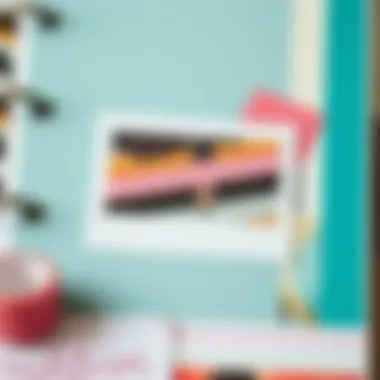

One of the biggest draws of washi tape is its wide range of designs and patterns. Whether you are looking for something subtle or a bit more eye-catching, there's a washi tape out there that will fit the bill. From florals to geometrics, you can find prints ranging from soft pastels to bold, vibrant colors. This diversity allows scrapbookers to match tape with themes, moods, or even the seasons.
This variety goes beyond mere aesthetics; the right washi tape can emphasize important elements in your scrapbook layout. For example, a shiny gold tape can draw attention to a pivotal photo, while a delicate floral tape might frame a handwritten note lovingly. When selecting washi tape, consider how the designs will interact with your overall visual story. The right choice can elevate your project from ordinary to striking.
Using a mix of different designs can lead to an engaging and layered look that captures the eye. Don't be afraid to experiment! Sometimes the oddest combinations yield the most captivating results. Be it stripes or polka dots, embracing the variety will allow for an invigorating creative process.
Materials and Quality
Quality in washi tape is essential; it affects not only how easy it is to work with but also how lasting your designs will be. Washi tape can differ greatly in terms of thickness, adhesive strength, and finish. Cheaper options may fray or lose their stickiness over time, which can be disappointing for shopworn scrapbooks. Look for brands known for high-quality washi tape that adheres well but is also easy to reposition.
When you are sourcing washi tape, focus on materials that are both eco-friendly and durable. Many manufacturers are now producing washi tape from recycled materials, contributing to sustainability in scrapbooking practices. Furthermore, high-quality tape often has a more vibrant color payoff, which is essential for any scrapbooker who wants their projects to pop.
For those looking to ensure their creations stand the test of time, it’s worth investing a bit more in quality products. Here are a few things to consider when assessing washi tape materials:
- Thickness: Thicker tapes typically offer better adhesion.
- Adhesive Quality: A good adhesive will allow for clean lines and easy repositioning.
- Finish Types: Consider if you prefer matte, glossy, or even metallic finishes based on your project’s needs.
In summary, understanding the materials and their overall impact can go a long way in making effective design choices in your scrapbooking projects. The marriage of countless designs with high-quality materials ultimately enhances the functionality and aesthetic appeal of washi tape.
“The key to great scrapbooking often lies in the little details—washi tape is one of those details that can make all the difference.”
Practical Applications of Washi Tape
Washi tape isn't just another crafting fad; it’s an essential tool that enhances various aspects of scrapbooking. While its aesthetic qualities attract users, the practical applications are what keep them coming back to this versatile medium. The following sections delve into how washi tape can elevate visual appeal, serve functional uses for organization, and showcase its adhesive properties, making it an ideal addition to any scrapbook collection.
Enhancing Visual Appeal
Washi tape’s vibrant colors and diverse patterns play a significant role in adding visual interest to scrapbook pages. The tape can break the monotony of traditional layouts, creating a sense of dynamism that speaks directly to the viewer. It’s like the icing on a cake; it might not be essential, but it sure makes everything more delightful.
Incorporating washi tape can help you:
- Create a focal point: Use bold patterned tapes to draw attention to specific photos or elements on the page, directing the viewer's gaze precisely where you want it.
- Add layers and depth: By layering different tapes, you can produce a textured look, giving particular scrapbook elements a three-dimensional quality that enhances overall appeal.
- Unify Themes: Different tapes can work together, harmonizing the color palette of your scrapbook and creating a cohesive design.
One popular technique is to use washi tape to border photos or journal entries. This simple addition can transform a plain page into a visually compelling narrative. When selecting designs, consider the emotions you wish to convey and how colors invoke different feelings in your audience.
Functional Uses in Organization
Beyond its decorative aspects, washi tape excels in the organizational realm, serving various practical functions that will make your crafting process smoother and more efficient. Many scrapbookers find themselves overwhelmed by the myriad of materials spread out during creative sessions. Washi tape is an efficient remedy for both clutter and chaos.
Here’s how washi tape can assist in organizing your scrapbook materials:
- Labeling: Use washi tape as a simple method for labeling sections or storage bins, allowing easy identification of materials without rummaging through each box.
- Color Coding: You can assign colors to various themes or projects, helping to streamline workflows. For instance, all materials related to a travel scrapbook might be marked with blue tape, while family projects use green tape.
- Bookmarks: For those who keep a collection of scrapbook ideas and sketches, washi tape can serve as effective bookmarks, ensuring important pages are easily accessible during crafting sessions.
When you incorporate functionality into aesthetics, washi tape bridges the gap between creative expression and organization. However, remember that too much tape in one spot can create clutter. Strike a balance to maintain the clean look of your projects.
Adhesion and Bonding Properties
An often-overlooked quality of washi tape is its adhesive properties. Unlike regular tape, washi tape offers a more forgiving bond, which is valuable when layering materials or making adjustments on the go. This ability to reposition elements makes it a popular choice for both novice and veteran scrapbookers alike.
Some aspects of washi tape’s adhesion to consider include:
- Reusability: You can peel it off and place it back without leaving nasty residues, allowing you to change layouts even after attempting your design.
- Temporary and Permanent Uses: Use it for temporary applications, like securing a layout before committing to more permanent adhesives. Conversely, in projects where you want a permanent bond, it works just as well as some traditional glues.
- Surface Compatibility: Washi tape adheres well to various surfaces, from photos to cardstock, making it a versatile option for your scrapbooking needs.
In sum, understanding the practical applications of washi tape can significantly enhance the overall quality and functionality of your scrapbooking projects. Whether you are sprucing up visual appeal, establishing organization in your workspace, or utilizing its unique bonding properties, washi tape stands as a crucial element in modern scrapbooking.
Creative Techniques with Washi Tape
Washi tape's charm in scrapbooking lies in its unique ability to elevate projects through various creative techniques. It’s not merely an adornment but rather a medium through which scrapbookers can express themselves. The vast array of colors, patterns, and textures available invites endless possibilities. Utilizing washi tape allows scrapbookers to explore their creativity while providing an arsenal of functions and aesthetic enhancements.
Layering and Texturing
Layering is a core technique when working with washi tape, serving both an artistic and practical purpose in scrapbooking. By overlapping different colors and patterns, scrapbookers can create a rich, textured effect. This helps to add depth to the pages, making them visually striking.
For instance, placing a delicate floral washi tape beneath a bold geometric pattern creates a delightful contrast that draws the eye. Remember to consider transparency as well; some washi tapes are semi-transparent, allowing for a subtle, blended look between layers.
- Pro Tip: When layering, use thinner strips for a more gradual transition between designs. This technique also helps in balancing the visual weight across the page, ensuring that no single part feels overwhelming.
- Texture can also be enhanced by varying the width of the tapes utilized. A narrow strip of washi can act as an accent alongside larger strips, introducing a playful touch without overwhelming the overall design.
Creating Borders and Frames
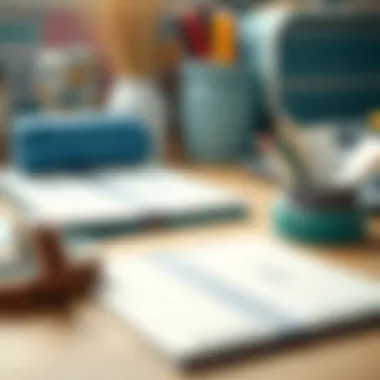

Washi tape can redefine the boundaries of scrapbook pages. Using it to create borders and frames is an effective way to emphasize sections of your scrapbook, guiding the viewer’s eye and making critical parts stand out. Imagine framing a cherished photo with a vibrant washi tape, giving it an art-gallery feel right in your craft space.
You can achieve this with minimal effort by simply applying the tape around the edges of the photo or a significant document. This simple technique adds finishing details that can transform a basic layout into a professional-looking gallery.
- Routine Recommendation: Consider using washi tape in different shades or complementary colors to create a more dynamic border. You might try combining two contrasting tapes for a fun, modern vibe.
- Ensure the corners are neatly mitered; folding the tape instead of cutting enhances the polished look.
Incorporating Typography and Quotes
Integrating typography and quotes is where washi tape becomes not only decorative but also functional. By using washi tape as a canvas for handwritten notes or printed quotes, scrapbookers can add personalized messages that resonate with the overall theme of their work.
Whether using a simple black and white tape for a classic look or a colorful one that complements the page, incorporating text can convey deeper emotions. It’s a great approach for those who want their scrapbooks to tell a story or share heartfelt sentiments.
- Quick Idea: Use clear adhesive for the tape to allow images and colors beneath to shine through. It makes the text pop while maintaining a cohesive look.
- Don't shy away from experimenting with different fonts, sizes, and alignments. Remember, the beauty of scrapbooking is in its uniqueness; let your personality shine through!
"Washi tape is a tool for artistic expression, offering both function and aesthetic appeal."
These techniques aren’t just tricks of the trade; they’re avenues to explore imaginative expression. This blend of functionality and creativity makes washi tape an essential element in modern scrapbooking.
Combining Washi Tape with Other Scrapbooking Materials
Washi tape stands out in scrapbooking not just for its vivid patterns and adhesive qualities, but also for its role as a bridge connecting various materials. Understanding how to combine washi tape with other scrapbook elements can elevate a project from mediocre to captivating. This section delves into the synergy achieved when washi tape interacts with papers and cardstock, as well as photos and memorabilia.
Using Washi Tape with Papers and Cardstock
Papers and cardstock serve as the heart of most scrapbooking projects, providing a canvas for creativity. When integrating washi tape, it’s essential to consider the weight and texture of the materials. For instance, lighter papers can benefit from the subtle adhesion of washi tape without being overwhelmed by its presence.
- Layering for Depth:
- Color Coordination:
- Creative Backgrounds:
- Pairing washi tape with patterned or solid cardstock can create a visually stunning effect. Use tape as a border or an accent, giving your layout a structured feel.
- Choose washi tape that complements or contrasts beautifully with your paper selection. For example, a soft pastel tape over bold geometric cardstock can add a pleasing visual balance.
- Consider creating a base layer with washi tape on plain cardstock, resulting in an intriguing, colorful backdrop for your photos. It’s a unique way to inject personality and distinction into your scrapbook.
Attention must also be given to how washi tape interacts with adhesives and glues. While it contributes a great design, sometimes extra glue is needed for securing heavier embellishments.
Integrating Photos and Memorabilia
Photos are often the main attractions in a scrapbook, but pairing them well with washi tape can boost their prominence further. Using washi tape around a photograph acts as a frame, guiding the viewer’s eye.
- Highlighting Memories:
- Holding Loose Memorabilia:
- Storytelling with Tape:
- Use washi tape to draw focus to significant photos. For example, framing a graduation picture with tape featuring academic prints adds a personal touch that speaks to the specific moment being commemorated.
- Washi tape's gentle adhesion makes it an excellent choice for attaching keepsakes or memorabilia, like ticket stubs or small notes. This way, they can be appreciated without permanently altering them.
- Create a visual story by layering washi tape behind photographs that relate to various moments captured. It can serve as a narrative tool, enhancing the context in which images are placed.
By combining washi tape with these various elements, you give your scrapbook a personal flair that reflects your unique style. This technique isn’t just about aesthetics; it creates a richer experience, inviting viewers to engage with your creations on multiple levels.
Combining washi tape with papers and photos not only enhances the overall look but also tells a deeper story within each layout.
In terms of maintenance, it’s wise to periodically check the adhesion of your washi tape, especially where it meets photos and keepsakes, to ensure they remain in tip-top shape for years to come. The harmony created by these combinations represents a spirited approach to scrapbooking that keeps the craft both innovative and meaningful.
Eco-Friendly Considerations
In today’s rapidly changing world, the conversation around sustainability has become a buzzword, reverberating across all industries, not least in the creative realms like scrapbooking. As artists and enthusiasts delve into this colorful world of artistry, it becomes paramount to assess the eco-friendly considerations surrounding materials used, especially with washi tape—a much-loved accessory in the scrapbooking community. Understanding the significance of eco-friendly practices isn’t just a passing trend; it’s an essential aspect that speaks to the responsibility of creatives to protect the environment while indulging their passions.
Sustainable Sourcing of Materials
When it comes to washi tape, the first step toward a greener approach lies in the sourcing of materials. Many companies are now prioritizing bamboo or recycled paper for their tape, which offers a more sustainable alternative compared to traditional plastic-based options. Bamboo is a fast-growing resource and can be harvested without causing damage to the ecosystem. Consequently, these choices help minimize deforestation and the wasteful production processes often seen in the paper industry.
Moreover, independent brands that focus on sustainability usually provide comprehensive details about their sourcing practices. Consumers can look for certifications or claims regarding the eco-friendliness of their products. A few brands, like The Paper Studio, specifically advertise their commitment to using sustainable materials, which sets them apart in a sea of less conscious competitors. Sustainable sourcing isn’t merely a marketing gimmick; it connects the end user with a broader effort toward environmental conservation.
Reducing Waste in Scrapbooking
In the bid to reduce waste, scrapbooking offers an avenue for creativity that is inherently aligned with recycling and repurposing. With washi tape’s versatility, scrapbooking can extend the life of various paper products that might otherwise be discarded. Instead of tossing aside leftover papers, scrapbookers can easily clip, fold, or layer these remnants, decorating them with washi tape to create something entirely new and special.
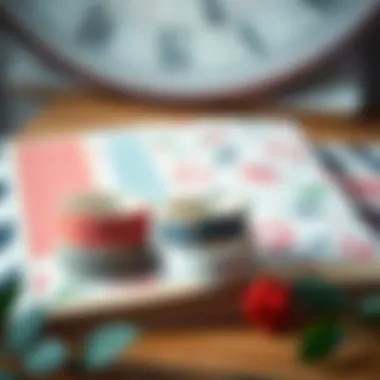

Here, reducing waste goes beyond the mere physical aspect; it engenders a mindset that encourages thrifting, mending, and transforming what might be perceived as waste into valuable, cherished keepsakes. Using washi tape for smaller embellishments or to create pockets for keepsakes means that the materials used in scrapbooking can see multiple uses, allowing for more sustainable practices across the board.
“Creativity is an endless resource, but the materials we use don’t have to drain the planet.”
In summary, incorporating washi tape into one’s scrapbooking routine invites not only a whimsical aesthetic but also a profound opportunity to engage in sustainable practices. Choosing sustainably sourced products and actively working to cut down waste isn’t just good for the planet; it reflects an evolving value system within the creative community that stresses accountability and care for the environment.
Washi Tape in Contemporary Scrapbooking Trends
The role of washi tape in contemporary scrapbooking trends presents a fascinating look at how this simple yet versatile material transforms personal narratives into visually stunning pieces of art. As both beginners and seasoned scrapbookers tap into their creativity, understanding these trends becomes crucial in developing a scrapping style that resonates with personal expression and current aesthetics. Today, we explore two significant trends: the tug-of-war between minimalism and maximalism, as well as the exciting fusion of digital and physical elements.
Minimalism vs. Maximalism
In the realm of scrapbooking, the minimalism versus maximalism debate showcases how washi tape can fit into vastly different artistic philosophies. Minimalistic scrapbookers emphasize simplicity. They prefer clean lines, ample white space, and a restrained color palette, relying on small quantities of well-chosen embellishments to convey their messages. In this context, washi tape serves as a subtle yet effective tool. A thin strip of beautifully patterned washi can frame a photo or accent a page, allowing the core elements to shine.
In contrast, the maximalist approach embraces abundance, often resulting in vibrant and eclectic compositions filled with layers and a mix of textures. Here, washi tape takes center stage, complementing various elements like photographs, stickers, and other embellishments. For maximalists, the playful and exaggerated use of washi tape creates a dynamic backdrop that enhances the overall energy of a layout.
- Minimalism focuses on:
- Maximalism's characteristics include:
- Clean designs
- Limited color schemes
- Focus on essential elements
- Bold patterns
- Layering of multiple elements
- Varied textures and colors
Each approach brings unique benefits to the table, but what truly matters is how scrapbookers blend these styles to create something authentically their own.
Fusion of Digital and Physical Elements
The fusion of digital and physical elements represents another significant contemporary trend in scrapbooking, further highlighted by the innovative use of washi tape. With the rise of digital tools, many scrapbookers are integrating computer-generated graphics, printed photographs, and digital color palettes into their physical layouts. Here, washi tape acts as a bridge between the tangible and the virtual, providing structures that help bind those elements together cohesively.
Using washi tape, scrapbookers can:
- Create a visual hierarchy between different elements.
- Add texture and depth to digitally printed backgrounds.
- Employ it as a temporary adhesion method, allowing for flexibility when arranging components.
Moreover, the incorporation of augmented reality into scrapbooking opens new avenues. Imagine using your phone or tablet to scan your scrapbook pages, causing elements like washi tape designs to come alive. This elaborate interplay adds a distinct layer to the creative process, ensuring that both forms of media can coexist beautifully.
"Washi tape not only embellishes pages but also acts as a medium for expression, bridging creativity with possibilities that seem limitless."
Understanding the current trends surrounding washi tape provides insight into the evolving nature of scrapbooking itself. Whether leaning towards minimalism, vying for maximalism, or blending both with digital artistry, the ways of incorporating washi tape are as diverse as the scrapbookers themselves. This adaptability keeps the scrapbook community vibrant and flourishing, constantly pushing the boundaries of creativity.
Tips for Choosing Washi Tape
When it comes to integrating washi tape into your scrapbooking arsenal, the selection process is crucial. Picking the right colors, designs, and qualities not only enhances the visual appeal but also amplifies the overall creative experience. Properly chosen washi tape can bridge gaps in your project, create focal points, and even contribute to its longevity.
Assessing Quality Over Quantity
In the craft world, the mantra often goes that less is more, but when it comes to quality, it's an entirely different ballgame. While it could be tempting to load up on rolls just because they're on sale or come in a trendy design, a discerning scrapbooker knows the importance of quality. High-quality washi tape adheres better, lasts longer without peeling, and offers a consistent finish.
- Adhesion: Low-quality tapes may not stick effectively to various surfaces, making them a frustrating addition to your project. You want tape that’s reliable and can withstand some handling.
- Finish and Texture: The feel and aesthetic of the tape can greatly affect how you perceive the artistry of your project. Choose tapes that reflect your unique style, whether it’s elegant, whimsical, or somewhere in between.
- Durability: Some tapes have a paper-thin quality that may tear easily. Look for tapes that maintain their integrity when applied and can be repositioned without leaving a gooey residue behind.
Ultimately, making an investment in quality over a multitude of cheaper options is a smart move. After all, the last thing you want is your favorite piece falling apart due to low-grade materials.
Matching Themes and Projects
Each scrapbook project tells its own story, and the washi tape you choose should complement that narrative. Matching themes to the right tape not only streamlines your creative process but can also amplify the impact of your visuals.
- Color Palette: Understanding the colors in your theme will guide your tape selection. For instance, earthy tones can harmonize beautifully with a nature-themed book, whereas bright and playful designs may befit a family vacation scrapbook.
- Seasonal Choices: Seasonal tapes serve as excellent tools for thematic projects. For example, snowflakes during winter themes or vibrant florals for spring can instantly evoke the feel of the respective season.
- Mixing and Matching: Don’t shy away from combining different designs to create contrast or cohesion. However, it’s crucial to be mindful of busy patterns competing for attention. A good rule of thumb is to use bold tapes where they can shine, while more subtle designs can fill in as backgrounds.
By deliberately matching your washi tape to the theme and mood of your project, you not only elevate its aesthetics but also ensure a more harmonious presentation. Taking the time to consider these elements will yield impressive results.
Choosing the right washi tape goes beyond personal preference; it’s about complementing your creative eloquence with the best materials possible.
For further inspiration on choosing washi tape, resources like Wikipedia on Washi Tape and crafting communities on Reddit are invaluable.
The End and Final Thoughts
In wrapping up our exploration of washi tape's role within the realm of scrapbooking, it’s clear that this simple yet versatile adhesive has made waves among crafters and creative minds alike. From its historical roots in Japan to its contemporary applications, washi tape has evolved to become not just a functional tool, but an essential medium for artistic expression.
One of the most significant aspects we have seen is the way washi tape enhances creativity. Unlike traditional adhesive materials, it offers a plethora of designs while being easy to manipulate. Its delicate yet strong structure allows scrapbookers to experiment without the fear of permanent damage. This encourages both novices and seasoned crafters alike to push their boundaries and try new techniques.
Moreover, the practical benefits cannot be overlooked. Washt tape lends itself to organizational purposes as well. It helps in arranging and categorizing elements within scrapbooks, ensuring that everything has a designated spot. The ability to reposition and remove without leaving sticky residue means one can continuously adapt their work, leading to a less stressful creative process.
Additionally, as we look towards the future, there are several exciting developments on the horizon for washi tape in scrapbooking. The integration of digital elements into physical scrapbooking processes is rapidly growing. A new breed of crafters is seamlessly merging traditional materials with technology, giving way to a broader spectrum of design possibilities.
"In the world of scrapbooking, washi tape doesn’t just stick; it inspires, organizes, and transforms."



